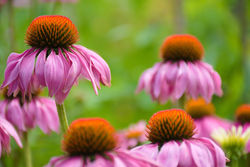9 lupine colors to grow in your garden
- Lars Wildes
- Feb 6, 2023
- 4 min read
Updated: Jun 16, 2023
With their tall spikes of colorful flowers and palm-like foliage, who doesn’t love lupines? They're available as both annuals and perennials, and they grow quickly, making them perfect for borders, containers, and empty spaces where you want bold, vibrant colors.
Speaking of color, lupines come in a rainbow of hues from hot pink and purple to yellow and white.
Take a scroll through the pictures below and start planning which colors of lupine you’ll add to your garden this year.
Bright pink lupines

While gorgeous, it’s important to note that lupines are toxic to humans and animals. Take care when planting them in your garden and make sure they’re out of reach of small hands.
Tip: Plant them in the middle of your borders, not on the edge. That way your pets and children won’t be able to reach them so easily. On the edges, plant edible plants like mint or violas.
Purple lupines

There are many different types of lupines, but the most- popular hybrid varieties are a cross between native species like Lupinus polyphyllus and other species like Lupinus arboreus.
These have been bred to maximize color and staying power.
Yellow lupines

The name Lupine comes from the idea that lupines were like “wolves” (lupus) eating all the nutrients out of the soil. But despite their reputation for depleting soil nutrients, lupines belong to the pea family (legumes) and can help to fix nitrogen in the soil.
Red lupines

For the best results, plant lupines in spring, either from seeds or cuttings. They prefer full sun, but some afternoon shade is fine if you’re living in a hot climate.
Pink and white lupines

They also like organically rich soil with good drainage and a neutral to slightly acidic pH.
White lupines

Keep your lupines on a regular watering schedule. But don’t overwater — they don’t like soggy soil and it can cause root rot. If you’re in a hot climate, add a layer of mulch to help retain moisture.
Orange lupines

Lupines are easily propagated from seed, but they have a tough seed coat. You’ll need to soak them overnight in water to soften the ‘shell’. Stick to seeds or cuttings when propagating — they’re very hard to divide and don’t respond well to having their root system chopped in two or moved.
Light-blue lupines

Purple and yellow lupines

How to grow and care for lupines
Height and spread
Lupines vary in size but generally grow up to 1-6 feet tall and 1-2 feet wide (30-182 cm and 30-60 cm).
Some lupine species, such as Texas Bluebonnet, can grow up to 1-2 feet tall and spread 2-3 feet wide (30-60 cm and 60-90 cm).
Other species, such as the Giant Lupine, can grow up to 6 feet tall (2 m) and spread 2-3 feet wide (60-90 cm). The size of the lupine depends on the species and growing conditions.
Types of lupine
There are over 200 species of Lupines, also known as lupin or lupine, in the Lupinus genus, legume family (Fabaceae).
You’ll see them everywhere from North and South America to Europe and Africa. And as we’ve seen above, this gorgeous flower comes in a rainbow of colors, sizes, and shapes.
Some of the most common species include:
Russell Lupine (Lupinus polyphyllus)
Texas Bluebonnet (Lupinus texensis)
Sundial Lupine (Lupinus pinnatus)
Miniature Lupine (Lupinus bicolor)
Arroyo Lupine (Lupinus succulentus)
Silvery Lupine (Lupinus argenteus)
Yellow Lupine (Lupinus flavus)
White Lupine (Lupinus albus)
Dwarf Lupine (Lupinus bartenfeldii)
Streambank Lupine (Lupinus rivularis)
How to plant lupines
How to plant mature lupine plants — When you bring home a lupine plant (ideally in the early spring), plant it in a hole with added organic matter and good drainage. You can add extra grit to help with the drainage.
Water it thoroughly for a few days until it has a chance to stabilize.
How to plant lupine seeds — Lupine seeds should be planted in the late spring and allowed to overwinter in the ground. They’ll bloom the following year.
Lay your lupine seeds on the soil and cover them with around ⅛” of soil (3 mm). Use your hand to press down the soil to make sure that the seeds and soil are firmly in place.
Water thoroughly and keep watering lightly until the seeds germinate — usually around 8-10 days.
How far apart should you space lupines?
Space mature lupine plants around 2-3 feet apart (60-90 cm) to accommodate for their spread.
Plant lupine seeds at the same distance or closer together. Lupines do not like to be moved, so plant them pretty much exactly where you want them.
Do lupines prefer full sun?
Yes, lupines need full sun to grow and bloom.
Plant them where they’ll receive at least 6 hours of direct sunlight. They can grow in partial shade, but you’ll end up with more foliage and way fewer blooms.
What type of soil do lupines need?
Lupines grow best in organically rich soil with good drainage and a neutral to slightly acidic soil pH.
They can even do well in poor soil because, as members of the pea family, they make their own nutrients in conjunction with bacteria found in nodules on their roots. Great news for all types of gardens!
That also means that lupines generally don't require fertilizer. Too much fertilizer can even result in fewer blooms.
How often should you water lupines?
Lupines don't like soggy soil, but they do benefit from regular watering.
To keep lupines from drying out, water them weekly. If you’ve gotten rain that week, don’t water them.
If you’ve planted in a container, use your finger to check the soil. If it’s dry, water thoroughly.

Do lupines change color?
Lupines do not change color in the sense that they undergo a transformation where they switch from one color to another.
However, some species of lupines are known to change color throughout their growth cycle, going from green to yellow to brown as they mature. Additionally, some lupine varieties have different colored flowers in the same plant or throughout different seasons.

Can bees change the color of lupines?
No, bees cannot change the color of lupines. The color of lupines is determined by the genetics of the plant, not by pollination or the magic of bees.
But bees and butterflies and other pollinators love lupines! Plant a few next to your vegetable garden to attract these friendly visitors to help pollinate your summer crops.





